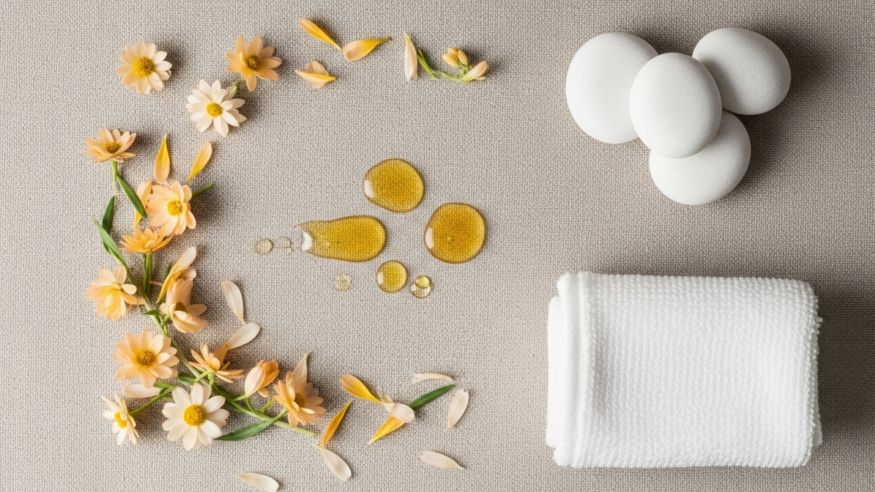
In the expansive world of natural skincare, certain ingredients stand out for their remarkable efficacy and historical reverence. Among these, helichrysum oil, often referred to as "liquid gold," holds a distinguished place. This powerful essential oil is renowned for its exceptional anti-inflammatory, antioxidant, and skin-rejuvenating properties, making it a sought-after botanical for those seeking a more radiant complexion.
Whether you're looking to diminish the appearance of fine lines, address stubborn acne scars, or soothe irritated skin, helichrysum oil for face and skin offers a compelling natural solution. This comprehensive guide will delve into the science-backed helichrysum oil benefits, provide essential insights into ideal dilution methods, and offer practical ways to incorporate this healing botanical into your daily routine. Prepare to unlock the potential for healthier-looking, revitalized skin.
What is Helichrysum Oil? The "Liquid Gold" of Skincare
At its core, helichrysum oil is an essential oil extracted from the Helichrysum italicum plant, a flowering herb native to the Mediterranean region. It is often affectionately called "Immortelle" or "Everlasting" due to its flowers retaining their vibrant color even after being picked and dried. For beginners, it's important to understand that an essential oil is a concentrated hydrophobic liquid containing volatile chemical compounds from plants. These compounds capture the plant's "essence" – its characteristic scent and, crucially for skincare, its beneficial properties.
The method of extraction, typically steam distillation of the fresh flowers and leaves, yields a potent and precious oil. Historically, helichrysum has been used in traditional medicine for its purported healing abilities, particularly for wounds and skin conditions. Its growing popularity in modern skincare is a testament to its multifaceted benefits, which we'll explore in detail. The unique chemical composition of helichrysum essential oil, rich in compounds like neryl acetate, alpha-pinene, and gamma-curcumene, contributes to its profound effects on skin health, earning it the moniker "liquid gold."
The Science-Backed Helichrysum Oil Benefits for Your Skin
The allure of helichrysum oil for skin extends far beyond anecdotal praise. Scientific research has begun to shed light on the mechanisms behind its remarkable effects. Here are some of the key helichrysum oil benefits that make it a skincare powerhouse:
Potent Anti-Inflammatory Action
Inflammation is a common culprit behind a myriad of skin concerns, manifesting as redness, swelling, irritation, and contributing to conditions like acne, eczema, and rosacea. Helichrysum oil contains compounds that are believed to exhibit significant anti-inflammatory properties, helping to calm and soothe irritated skin. Studies have indicated that helichrysum essential oil can help reduce inflammatory responses, making it an excellent choice for sensitive or reactive complexions [2], [6]. By mitigating inflammation, it can reduce the visible signs of irritation and promote a more even skin tone.
Powerful Antioxidant Properties
Our skin is constantly exposed to environmental aggressors like pollution and UV radiation, which generate harmful free radicals. These unstable molecules can damage skin cells, accelerate the aging process, and lead to the formation of fine lines, wrinkles, and dark spots. Helichrysum oil is rich in antioxidants, compounds that neutralize free radicals and protect skin cells from oxidative stress [6]. This protective action helps to preserve the skin's youthful appearance and promotes overall skin vitality, directly supporting the reduction of visible signs of aging.
Promoting Skin Rejuvenation and Healing
One of the most celebrated helichrysum oil benefits is its ability to support the skin's natural regenerative processes. It is believed to aid in skin cell proliferation and improve skin elasticity, both crucial factors in maintaining healthy, resilient skin [1]. This makes it particularly beneficial for addressing concerns like acne scars, which result from damaged skin tissue. By supporting the healing process and encouraging healthy tissue regeneration, helichrysum oil can help minimize the appearance of scars and promote a smoother, more uniform skin texture. Furthermore, its potential to accelerate wound healing has been explored in various applications, underscoring its role in skin repair [1], [2], [3], [7].
Antimicrobial Support for Clearer Skin
For those struggling with breakouts or general skin hygiene, the antimicrobial properties of helichrysum oil are particularly valuable. Research suggests that helichrysum essential oil possesses antibacterial and antifungal potential [4], [5]. While it's not a direct treatment for medical conditions, these properties can contribute to maintaining a healthy skin microbiome, potentially helping to keep certain bacteria that contribute to acne at bay and supporting overall skin cleanliness. This can indirectly lead to clearer skin and fewer blemishes over time.
How to Safely Use Helichrysum Oil for Face and Skin
Given the potency of essential oils, proper application and safety precautions are paramount, especially when using helichrysum oil for face and sensitive skin areas. Here's what you need to know:
The Importance of Dilution
Never apply undiluted helichrysum essential oil directly to your skin, particularly on your face. Essential oils are highly concentrated and can cause skin irritation or sensitization if used neat. Dilution with a carrier oil is essential. Carrier oils are vegetable oils derived from the fatty portion of a plant, such as the nut or seed. They help to "carry" the essential oil onto the skin, facilitate absorption, and dilute its potency, making it safe for topical application. Excellent choices for facial application include:
- Jojoba Oil: Mimics skin's natural sebum, making it ideal for all skin types, including oily and acne-prone.
- Argan Oil: Rich in vitamin E and fatty acids, great for anti-aging and moisturizing.
- Rosehip Oil: Known for its skin-regenerating properties, excellent for scars and hyperpigmentation.
- Sweet Almond Oil: A gentle, nourishing oil suitable for most skin types.
For facial use, a general dilution guideline is 1-2% essential oil. This translates to about 6-12 drops of helichrysum oil per ounce (30ml) of carrier oil. For body applications, a slightly higher concentration of 2-5% can be used, but always start with lower dilutions and increase if tolerated.
Patch Testing: A Non-Negotiable Step
Before applying helichrysum oil for skin extensively, especially on your face, always perform a patch test. This simple step can help identify any potential skin sensitivities or allergic reactions. To perform a patch test:
- Dilute a small amount of helichrysum essential oil with your chosen carrier oil (e.g., 1-2 drops in a teaspoon of carrier oil).
- Apply a tiny amount of this diluted mixture to an inconspicuous area of skin, such as the inside of your forearm or behind your ear.
- Cover the area with a bandage and leave it for 24-48 hours.
- Monitor for any signs of redness, itching, swelling, or irritation. If any reaction occurs, wash the area thoroughly with soap and water and discontinue use. If no reaction occurs, you can proceed with broader application.
Quality Matters: Choosing Your Helichrysum Essential Oil
The efficacy and safety of helichrysum oil largely depend on its quality. Look for pure, unadulterated, and therapeutic-grade essential oils from reputable suppliers. Ensure the label clearly states the botanical name (Helichrysum italicum) to avoid confusion with other Helichrysum species that may not offer the same benefits. Avoid oils that contain synthetic fragrances, fillers, or other additives, as these can negate the natural benefits and potentially cause adverse reactions. Reputable brands often provide information on their sourcing, distillation methods, and third-party testing, ensuring purity and potency.
Incorporating Helichrysum Oil into Your Daily Skincare Routine
Once you've ensured safe usage, integrating helichrysum oil for face and overall skin health can be a transformative experience. Here are several ways to make this "liquid gold" a staple in your beauty regimen:
Targeted Treatment for Fine Lines and Wrinkles
Thanks to its antioxidant properties and ability to support skin rejuvenation, helichrysum oil can be a valuable addition to an anti-aging routine. Create a custom facial serum by adding 6-12 drops of helichrysum essential oil to 1 ounce of a nourishing carrier oil like argan or rosehip oil. After cleansing and toning, apply a few drops of this serum to your face and neck, gently massaging it into areas prone to fine lines, such as around the eyes and mouth. For best results, incorporate this into your nightly routine, allowing the oil to work its magic while you sleep.
Addressing Acne Scars and Blemishes
The skin-regenerating properties of helichrysum oil for skin make it an excellent natural ally in the battle against acne scars and hyperpigmentation. For spot treatment, dilute 1-2 drops of helichrysum oil in a teaspoon of a carrier oil like jojoba oil or tamanu oil (known for its scar-healing properties). Dab this mixture directly onto individual scars or blemishes using a clean cotton swab. For more widespread scarring, you can incorporate the helichrysum-infused serum mentioned above into your full-face routine. Consistency is key here, as scar fading takes time.
Soothing Irritated or Red Skin
If you experience redness, inflammation, or general skin irritation, the anti-inflammatory power of helichrysum oil can provide significant relief. For localized irritation, dilute 1-2 drops of helichrysum essential oil in a small amount of aloe vera gel or a gentle carrier oil like sweet almond oil, then gently apply to the affected area. For a calming facial mist, add 5-10 drops of helichrysum oil to 4 ounces of distilled water or witch hazel in a spray bottle. Shake well before each use and mist onto your face throughout the day to refresh and soothe inflamed skin.
DIY Skincare Recipes with Helichrysum Oil
Creating your own helichrysum oil for face formulations allows you to customize your skincare to your specific needs. Here are a couple of simple recipes:
1. Rejuvenating Facial Serum:
- 1 oz (30ml) Jojoba Oil
- 10 drops Helichrysum Essential Oil
- 5 drops Frankincense Essential Oil (optional, for anti-aging)
- 5 drops Lavender Essential Oil (optional, for soothing)
Combine all ingredients in a dark glass dropper bottle. Apply 3-5 drops to cleansed face and neck morning and night.
2. Calming Facial Oil Blend for Irritation:
- 1 oz (30ml) Sweet Almond Oil or Calendula-infused Oil
- 12 drops Helichrysum Oil
- 6 drops Chamomile (Roman) Essential Oil
Mix in a dark glass bottle. Gently massage a small amount onto irritated areas as needed.
Important Considerations and Precautions
While helichrysum oil is generally well-tolerated when used correctly, it's crucial to adhere to safety guidelines to ensure a positive experience:
- Always Dilute: As reiterated, never apply helichrysum essential oil neat to the skin. Proper dilution is non-negotiable.
- Avoid Eyes and Mucous Membranes: Keep essential oils away from your eyes, inner ears, and other sensitive mucous membranes. If accidental contact occurs, rinse thoroughly with a carrier oil (not water) to dilute the oil.
- Internal Use: This article focuses solely on topical application for skincare. Do not ingest helichrysum oil unless specifically directed and supervised by a qualified healthcare professional.
- Consult Professionals: If you are pregnant, nursing, have a medical condition, or are taking medication, consult your doctor or a qualified aromatherapist before using helichrysum oil. This article provides general information and does not constitute medical advice.
- Storage: Store helichrysum oil in a cool, dark place, away from direct sunlight and heat, to preserve its potency and extend its shelf life. Keep out of reach of children and pets.
- Individual Sensitivity: Even after a patch test, be mindful of how your skin reacts. Discontinue use if any irritation occurs.
Conclusion
Helichrysum oil, often celebrated as "liquid gold," offers a wealth of benefits for those seeking to enhance their skin's health and appearance. From its powerful anti-inflammatory and antioxidant properties to its remarkable ability to support skin rejuvenation and healing, this essential oil provides a holistic approach to skincare. By understanding how to safely and effectively use helichrysum oil for face and body, you can harness its potent botanical power to address concerns like fine lines, acne scars, and irritation. Incorporating this healing botanical into your daily routine, always with proper dilution and patch testing, can pave the way for a more radiant, healthier-looking complexion. Embrace the wisdom of nature and discover the transformative potential of helichrysum oil for skin.
References
- PVA and PVP nanofibers combined with Helichrysum italicum oil preserve skin cell interactions, elasticity and proliferation.
- Evaluation of sodium alginate sponge infused bromelain spray and Helichrysum italicum nanoemulsion to accelerate wound healing.
- Immortelle Essential-Oil-Enriched Hydrogel for Diabetic Wound Repair: Development, Characterization, and In Vivo Efficacy Assessment.
- Antibacterial and Antifungal Potential of Helichrysum italicum (Roth) G. Don Essential Oil.
- Combination of Chromatographic Analysis and Chemometric Methods with Bioactivity Evaluation of the Antibacterial Properties of Helichrysum italicum Essential Oil.
- An integrated in vitro approach on the enzymatic and antioxidant mechanisms of four commercially available essential oils (Copaifera officinalis, Gaultheria fragrantissima, Helichrysum italicum, and Syzygium aromaticum) traditionally used topically for their anti-inflammatory effects.
- Fish Scale Gelatin Nanofibers with Helichrysum italicum and Lavandula latifolia Essential Oils for Bioactive Wound-Healing Dressings.


